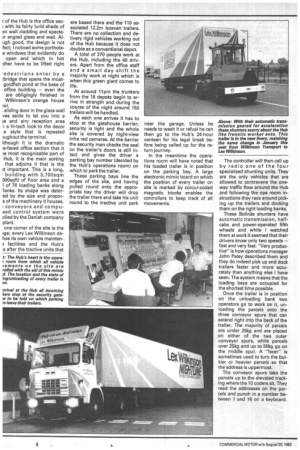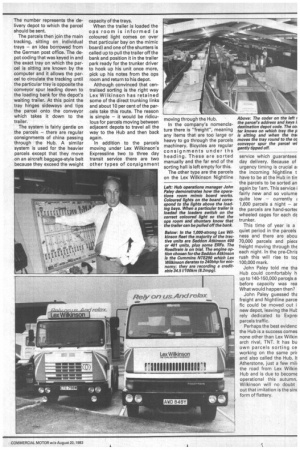Green giant at the hub al Lex Wilkinson's universe
Page 43

Page 44

Page 45

If you've noticed an error in this article please click here to report it so we can fix it.
"IT DIDN'T HAVE to look the way it does. But it was designed from scratch to be a marketing tool as well as a parcels sorting centre."
So said John Paley, operations manager at Lex Wilkinson's Hub. There is evidence that the Hub is succeeding in both these roles.
First and foremost, as a cornputerised and mechanised parcels sortation centre it works. In 1980 the average transit time for Wilkinson Transport (as it was then called) parcels was 2.6 days and 56 per cent were delivered in two days. By the end of 1982 the average transit time had dropped to 2.2 days and 80 per cent were delivered in two days. The Hub was opened in the intervening time and can take most of the credit for the service improvement.
The fact that you are reading about the Hub at the moment is evidence that it has also succeeded as a marketing tool. It is almost certainly the best-known road freight terminal in the UK and each year Lex Wilkinson proudly shows over 1,000 visitors around the Hub, despite the fact that they have to come at night to see it in full swing.
In its pre-Hub days Wilkinson Transport carried out direct trunking between each one of its 16 depots. This worked (and still does for many companies) but entails a veritable cat's cradle of trunk runs and Wilkinson Transport was not convinced it was the most efficient way.
The company looked at comparable operations in America and examined the principle of centralised parcels sorting whereby each depot trunked its parcels to just one central poi where they were sorted al moved on to the correct destir tion depot.
Wilkinson liked what it sz and although the Americi systems need more than o centre because of the sheer si of the country, Wilkinson Trar port decided that a single cent provided it was carefully sitL ted, could give the efficie national coverage it sought.
The carefully chosen squat', for the Hub turned out to be t Nuneaton area of Warwickshi It is an eminently logical choic it is as near dead centre as y, can get — bearing in ml population distribution — and sitting pretty near the k, motorway junctions of the r with the M6 and the M1 with t M5.
It was the Bermuda Indust! Estate at Bedworth a few mi south of Nuneaton that was cf sen for the Hub, and Wilkins Transport became the first oci piers on the .estate by takirq 10-acre site. It is virtually ides placed, being just a mile or from junction 3 of the M6.
The architect's brief to col up with a marketing tool as as a practical parcels sorti centre resulted in the Hub, wh was opened on September 1980 at a cost of £5.5 million.
It came on stream gradui as, one by one, direct trunks tvveen the depots were replac with trunks to and from the H Six months later all the "spoki were complete; the Hub v rolling and the direct trunk network became part of Will son Transport history.
Any form of centralisat supposedly makes an organi tion more vulnerable breakdown or industrial act — all its eggs are in one basl Lex Wilkinson said this has been a problem and thatit cf have contingency plans to sume direct trunking if sucl situation arose.
The most visually distinc.
t of the Hub is the office sec with its fairly lurid shade of en wall cladding and spect-a)r angled glass end wall. Alugh good, the design is not feet; I noticed some portholee windows that evidently do open and which in hot ither have to be lifted right edestrians enter by a :bridge that spans the moatgoldfish pond at the base of office building — even the are obligingly finished in Wilkinson's orange house )u r.
sliding door in the glass wall yes aside to let you into a le and airy reception area -1 a hi-tech look to the decor a style that is repeated )ughout the terminal.
'though it is the dramatic ;s-faced office section that it le most recognisable part of Hub, it is the main sorting that adjoins it that is the ;t important. This is a long, • building with 3,700sqm DOOsqft) of floor area and a I of 76 loading banks along bilks. Its shape was detered by the size and propors of the machinery it houses.
conveyors and cornpused control system were plied by the Danish company plant.
one corner of the site is the ige; every Lex Wilkinson dehas its own vehicle mainten3 facilities and the Hub's
s after the tractive units that are based there and the 110 associated 12.2m boxvan trailers. There are no collection and delivery rigid vehicles working out of the Hub because it does not double as a conventional depot.
A total of 270 people work at the Hub, including the 40 drivers. Apart from the office staff and a small day shift the majority work at night which is when this green giant comes to life.
At around 11pm the trunkers from the 16 depots begin to arrive in strength and during the course of the night around 150 trailers will be handled.
As each one arrives it has to stop at the gatehouse barrier; security is tight and the whole site is covered by night-view infra red cameras. At the barrier the security man checks the seal on the trailer's doors is still intact and gives the driver a parking bay number (decided by the Hub's operations room) on which to park the trailer.
These parking bays line the edges of the site, and having pulled round onto the appropriate bay the driver will drop the trailer there and take his unit round to the tractive unit park near the garage. Unless he needs to wash it or refuel he can then go to the Hub's 24-hour canteen for his legal break before being called up for the return journey.
In the meantime the operations room will have noted that his loaded trailer is in position on the parking bay. A large electronic mimic board on which the position of every trailer on site is marked by colour-coded magnetic blocks enables the controllers to keep track of all movements. The controller will then call up by radio one of the four specialised shunting units. They are the only vehicles that are allowed to contravene the oneway traffic flow around the Hub and following the ops room instructions they race around picking up the trailers and docking them on the right loading banks.
These Bollnas shunters have automatic transmission, halfcabs and power-operated fifth wheels and while I watched them at work it seemed that their drivers know only two speeds — fast and very fast. "Very productive" is how operations manager John Paley described them and they do indeed pick up and dock trailers faster and more accurately than anything else I have seen. The system means that the loading bays are occupied for the shortest time possible.
Once the trailer is in position on the unloading bank two operators go to work on it, unloading the parcels onto the three conveyor spurs that can extend right into the back of the trailer. The majority of parcels are under 25kg and are placed on either of the two outer conveyor spurs, while parcels over 25kg and up to 50kg go on the middle spur. A "facer" is sometimes used to turn the bulkier or heavier parcels so that the address is uppermost.
The conveyor spurs take the parcels up to the elevated tracking where the 10 coders sit. They read the addresses on the parcels and punch in a number between 1 and 16 on a keyboard. The number represents the delivery depot to which the parcel should be sent.
The parcels then join the main tracking, sitting on individual trays — an idea borrowed from the German post office. The depot coding that was keyed in and the exact tray on which the parcel is sitting are known by the computer and it allows the parcel to circulate the tracking until the particular tray is opposite the conveyor spur leading down to the loading bank for the depot's waiting trailer. At this point the tray hinges sideways and tips the parcel onto the conveyor which takes it down to the trailer.
The system is fairly gentle on the parcels — there are regular consignments of china passing through the Hub. A similar system is used for the heavier parcels except that they move on an aircraft baggage-style belt because they exceed the weight capacity of the trays.
When the trailer is loaded the ops room is informed (a coloured light comes on over that particular bay on the mimic board) and one of the shunters is called up to pull the trailer off the bank and position it in the trailer park ready for the trunker driver to hook up his unit once more, pick up his notes from the ops room and return to his depot.
Although convinced that centralised sorting is the right way Lex Wilkinson has retained some of the direct trunking links and about 10 per cent of the parcels take this route. The reason is simple — it would be ridiculous for parcels moving between adjacent depots to travel all the way to the Hub and then back again.
In addition to the parcels moving under Lex Wilkinson's Expressline two to three day transit service there are two other types of consignment In the company's nomenclature there is "freight", meaning any items that are too large or heavy to go through the parcels machinery. Bicycles are regular consignments under ths heading. These are sorted manually and the far end of the sorting hall is left empty for this.
The other type are the parcels on the Lex Wilkinson Nightline service which guarantees day delivery. Because of urgency timing is crucial ai the incoming Nightline t have to be at the Hub in tin the parcels to be sorted an again by lam. This service i fairly new and so volume quite low — currently 1,600 parcels a night — ar the parcels are hand-sortec wheeled cages for each de trunker.
This time of year is a quiet period in the parcels ness and there are abou 70,000 parcels and piecE freight moving through thE each night. In the pre-Chris rush this will rise to tor 100,000 mark.
John Paley told me tha Hub could comfortably h up to 140-150,000 parcejs a before capacity was rea What would happen then?
John Paley guessed th freight and Nightline parce fic could be moved out i new depot, leaving the Hut rely dedicated to Expret parcels traffic, Perhaps the best evidenc the Hub is a success comes none other than Lex Wilkin arch rival, TNT. It has bu own parcels sorting ce working on the same prir and also called the Hub. It Atherstone, just a few mill the road from Lex Wilkin Hub and is due to become operational this autumn. Wilkinson will no doubt out that imitation is the sinc form of flattery.
















































































